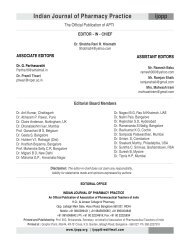Oct-Dec, 2011 - Indian Journal of Pharmacy Practice
Oct-Dec, 2011 - Indian Journal of Pharmacy Practice
Oct-Dec, 2011 - Indian Journal of Pharmacy Practice
- No tags were found...
You also want an ePaper? Increase the reach of your titles
YUMPU automatically turns print PDFs into web optimized ePapers that Google loves.
Anantha Naik N -Health Related Quality <strong>of</strong> Life Instrumentsby explaining the extent <strong>of</strong> difficulty with activities <strong>of</strong> dailyliving (including work, recreation, and householdmanagement) and how these difficulties affect relationshipswith family, friends, and social groups. When measuringHRQL it is important that the instrument selected measuresthe health dimensions relevant to that particular set <strong>of</strong>patients. For instance, an instrument intended for use withpatients after myocardial infarction (MI) should take intoaccount the individual's responses to living with the disease,in terms <strong>of</strong> recreational, occupational, social, personal andsexual relationships, as well as the acute and chronic physicalconsequences <strong>of</strong> the disease. This is because when someone isill almost all aspects <strong>of</strong> his or her life may be affected.HRQoL instruments <strong>of</strong>ten contain questions that measurebody function (e.g., pain, depression, anxiety) and limitationswith participation in the activities. HRQoL instruments aredeveloped and evaluated according to psychometricprinciples <strong>of</strong> test theory. This theory proposes that HRQoLvalue can be measured indirectly by asking a series <strong>of</strong>questions. The answers to these questions are then assignednumerical values and these numerical values are combined toyield 'scale scores'. These scale scores are further combined toyield domain scores or summary scores that are eitherstatistically computed or preference based.R O L E O F H R Q o L I N S T R U M E N T S I NPHARMACOECONOMIC EVALUATIONSScarce availability <strong>of</strong> resources in society compels decisionmakersto balance the benefits and risks <strong>of</strong> treatment whenthey make decisions for patients. One must also take intoaccount that benefits gained are worth the resources that mustbe spent in providing them. When the resources <strong>of</strong> family arelimited it has to forgo other benefit, which necessitate theneed for economic analysis to aid informed decision making.The HRQoL instruments can be used to study benefit gainedor perceived by the patients against the resources consumed,thus helping in economic evaluation.The HRQoL instrument chosen will gives us values or utilitieswhich can be understood by the type <strong>of</strong> question in theinstrument. If questions are asked about certain outcomes itgives us values and if uncertain outcomes it gives us utilities.MEASUREMENT OF HEALTH STATUSPatient preferences for alternative health states can bemeasured either by Time Trade-Off Method or StandardGamble Method. The Time Trade-Off measures values whereas Standard Gamble measures utilities.31. Time Trade-Off Method :In Time Trade-Off patients are asked to imagine living theirlife in present state and to contrast alternative life in perfecthealth for exchange <strong>of</strong> shorter life period. Patients are posedwith alternative years <strong>of</strong> life in present status against the years<strong>of</strong> life in perfect health state. Further the Quality AdjustedLife Years (QALYs) is calculated as followsNo. <strong>of</strong> Years Remaining – No. <strong>of</strong> Years SacrificedQALYs= ____________________________________________No. <strong>of</strong> Years RemainingSo, for example, if an individual with 30 years <strong>of</strong> liferemaining with hip fracture due to osteoarthritis is ready totrade <strong>of</strong>f 15 years to achieve rest <strong>of</strong> 15 years in full health, theQALYs <strong>of</strong> 1 year with hip fracture due to arthritis would be0.5.42. Standard Gamble Method :Standard Gamble method measures utility and is based on theUtility Theory, first proposed by Neumann and Morgenstern.The Utility Theory describes how a rational individual makesdecisions when facing uncertainty. Here, patients were askedto imagine about an intervention that would result into perfecthealth but with associated risk <strong>of</strong> death. Further patients areasked to indicate the highest probability <strong>of</strong> death risk they arewilling to accept against choosing to remain in their presenthealth condition. If the perceived value <strong>of</strong> the current healthcondition is low, patient is ready to accept larger probability<strong>of</strong> death risk. Patients are asked to place the utility <strong>of</strong> presenthealth between death (value 0) and full health (value 1).For example, if a woman suffering from breast cancer isimpassive between her current health state and is willing togamble when the probability <strong>of</strong> dying is 50%. This wouldmean that the utility the individual places on a year in thathealth state is 0.5, against a year in perfect health, whichwould be worth 1.0.Visual Analogue Scale (VAS) is another commonly usedvalue based measure. VAS allows patients to rate their health5status 0 meaning worst and 100 meaning best.Preference and perception measuring for health states byeither Standard Gamble or Time Trade-Off can be timeconsuming and complex. Hence recently developed prescoredmulti-attribute health status classification system isgaining more popularity among researchers. In theseinstruments, patients were asked to rate their ability t<strong>of</strong>unction in physical, emotional, and social aspects <strong>of</strong> life.Here patients report their health state rather than theirpreference for different health states. Some commonly usedinstruments under this category are European Quality <strong>of</strong> Life<strong>Indian</strong> <strong>Journal</strong> <strong>of</strong> <strong>Pharmacy</strong> <strong>Practice</strong> Volume 4 Issue 4 <strong>Oct</strong> - <strong>Dec</strong>, <strong>2011</strong> 22
















